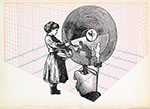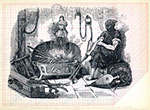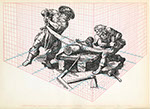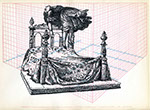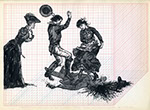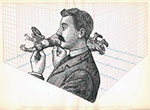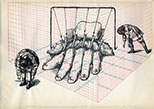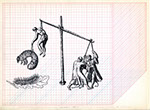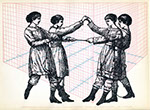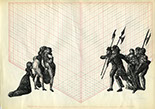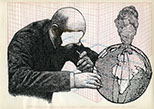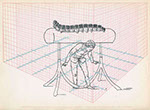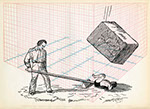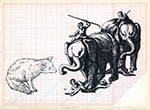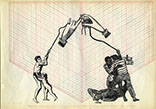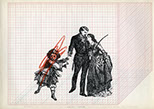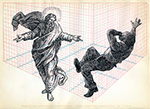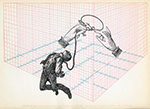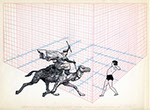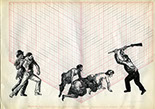PERSPECTA
Benjamin Monti is a young Belgian artist who "situates himself at the crossroads of text, graphic art and the fine arts."(1) Active for some ten years now, he is constantly exploring new dialogues between drawing and text, notably in the form of the graphic novel and private diary. In his early days, an introspective tendency impelled him to cover the pages of a railway ledger with convulsive writing reflecting a deep existential unease. Then he developed a practice in which drawing and writing intertwine. His current works function as what he calls "suspended moments"-excerpts from stories still to be invented. A big fan of prints and literature, Monti is a diver for rare pearls. He starts by analysing the relativity of all representations of this world, but with a particular interest in popular imagery and the realist aesthetic, which constitutes an effective support for projections. He draws liberally on this global corpus full of images that may be forgotten but are always eloquent. Monti mixes extreme fidelity to the model with the subtlest of discrepancies. He traces his chosen pictures like a contemporary copyist concerned with the transmission and integration of collective references. The protagonists in his drawings come from family encyclopaedias, holy images or recreations of crimes. Severed from their original context, these humans, beasts and plants lead a weightless life in the space of the paper as actors in the theatre of the strange and the absurd. Gymnasts, bourgeois, martyrs and coleopterans connect or cohabit in mutual ignorance. They find their way between snatches of text and some very diverse diagrams. The equation stimulates the imagination.
Right from his debut, Monti has always preferred black ink. It was the medium of necessity in the days when he contributed to the Mycose collective fanzine, because it came out best in print. Today, the depth of Indian ink applied by pen is key to what -he does. Sharp as a blade, his controlled yet vibrant line matches the caustic darkness of his universe. The graphic novel Vide shows just how much evocative power he manages to wring from the confrontation between black and white, in an echo of existential quest ions. A specialist at recycling images, Monti applies the same logic of recuperation to his choice of supports. From a wad of old forms he took the order slips, outdated diaries and account ledgers. His keen eye homes in on the plastic potential of mass -printed functional documents. His latest works include a set of drawings conceived on the basis of perspective grids, Perspecta. Most of them can be read individually, but there are exceptions, notably Diptyque, a nod to the history of Western art: on one side, jovial bibbers raise their glasses to Christ's health, while on the other the wretched implore a drunken singer. The overall effect is due to the simplicity of the procedure: partial inversion leads to an irreverent encounter between sacred and profane. The squared background reminds us that every image is a construction, a reading of the world, and therefore debatable. Another original support lies behind the creation of the Succession Ab intestat series (2009-10). This was a notebook used by a law student in 1901. Observing the texture of the paper, the watermark, the care and inflections of the writing, and the corrections, Monti saw an opening for an intervention, one that brings out the existing elements while injecting an element of tension. He used invisible ink to address the connect ions between the visible and the invisible, absence and presence. This document reminded him of his own childhood as a dyslexic. Driven by the desire to be able to read, and to have access to t he books in his parents ' well-stocked shelves, he held out against the rigidity of the school system. After many years as a hesitant writer, he now cultivates rigor and method. Several of his works take the form of daily duties or punishments, inasmuch as he imposes strict rules and Stakhanovist productivity on himself. Further, the question of learning is like a leitmotiv in his thoughts. The ideology perpetuated by school textbooks is central to several of his works, including the very recent pieces in which he reactivates illustrations from beg inners' books for learning Dutch and English. Winners of the prize for a young artist awarded by the Parliament of the French Community, his Zonder titel (2010) and Untitled (2010) can be seen as a mordant allusion to the nationalism and intercommunity ructions now paralyzing Belgium. Monti 's promising work evokes the fundamentals of human experience: between life and death, everything is constantly being transformed and recreated. (Alexia Creusen, in Art Press)
----> Cliquer sur les vignettes
----> Lire en français




















